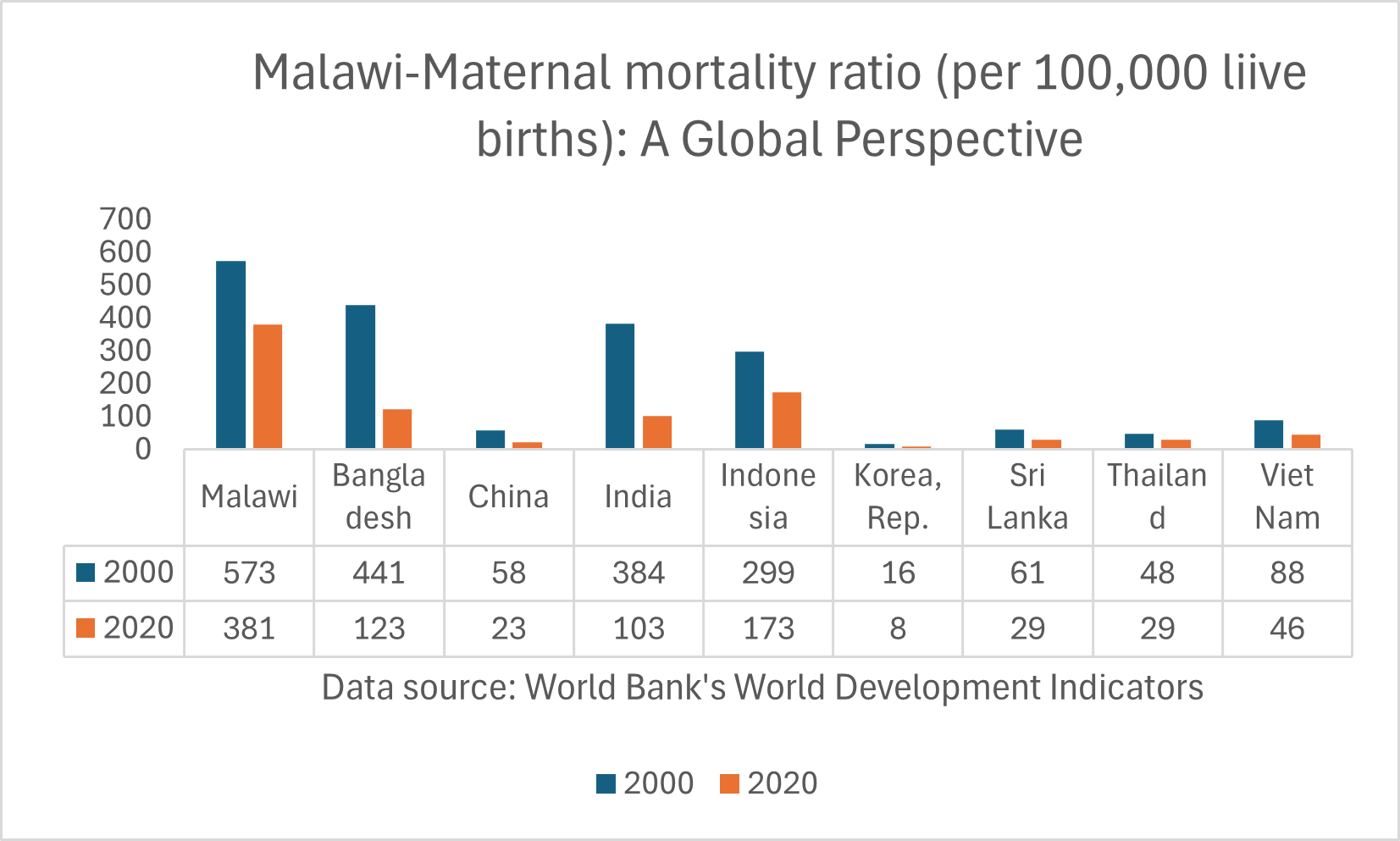
Malawi
Country Flag Details
three equal horizontal bands of black (top), red, and green with a radiant, rising, red sun centered on the black band; black represents the native peoples, red the blood shed in their struggle for freedom, and green the color of nature; the rising sun represents the hope of freedom for the continent of Africa.
Background
From the late 15th to the 18th centuries, a prosperous Kingdom of Maravi — from which the name Malawi derives — extended its reach into what are now areas of Zambia and Mozambique. In 1889, a British Central African Protectorate was established, which was renamed Nyasaland in 1907 and became the independent nation of Malawi in 1964.
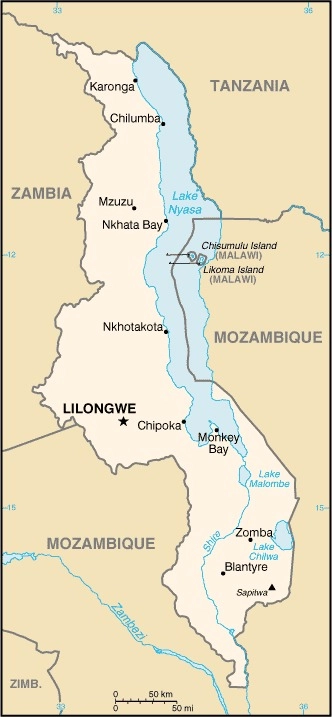
Geography
Area
total : 118,484 sq km
land: 94,080 sq km
water: 24,404 sq km
Climate
sub-tropical; rainy season (November to May); dry season (May to November)
Natural resources
limestone, arable land, hydropower, unexploited deposits of uranium, coal, and bauxite
People and Society
Population
total: 21,763,309
Ethnic groups
Chewa 34.3%, Lomwe 18.8%, Yao 13.2%, Ngoni 10.4%, Tumbuka 9.2%, Sena 3.8%, Mang’anja 3.2%, Tonga 1.8%, Nyanja 1.8%, Nkhonde 1%, other 2.2%, foreign 0.3% (2018 est.)
Languages
English (official), Chewa (dominant), Lambya, Lomwe, Ngoni, Nkhonde, Nyakyusa, Nyanja, Sena, Tonga, Tumbuka, Yao
Religions
Protestant 33.5% (includes Church of Central Africa Presbyterian 14.2%, Seventh Day Adventist/Baptist 9.4%, Pentecostal 7.6%, Anglican 2.3%), Roman Catholic 17.2%, other Christian 26.6%, Muslim 13.8%, traditionalist 1.1%, other 5.6%, none 2.1% (2018 est.)
Population growth rate
2.22% (2024 est.)
Government
Government type
presidential republic
Capital name: Lilongwe
Executive branch
chief of state: President Lazarus CHAKWERA (since 28 June 2020)
head of government: President Lazarus CHAKWERA (since 28 June 2020)
Economy
Economic overview
low-income East African economy; primarily agrarian; investing in human capital; urban poverty increasing due to COVID-19; high public debt; endemic corruption and poor property rights; poor hydroelectric grid; localized pharmaceutical industry
Real GDP (purchasing power parity)
$34.789 billion (2023 est.)
$34.143 billion (2022 est.)
$33.832 billion (2021 est.)
Real GDP per capita
$1,600 (2023 est.)
$1,700 (2022 est.)
$1,700 (2021 est.)
Exports
$1.526 billion (2023 est.)
$1.487 billion (2022 est.)
$1.587 billion (2021 est.)
Exports – partners
Germany 11%, India 7%, Zimbabwe 6%, South Africa 5%, USA 5% (2023)
Exports – commodities
tobacco, tea, dried legumes, soybean meal, raw sugar (2023)
Imports
$3.995 billion (2023 est.)
$3.834 billion (2022 est.)
$3.768 billion (2021 est.)
Imports – partners
China 17%, South Africa 16%, UAE 12%, India 7%, Tanzania 7% (2023)
Imports – commodities
refined petroleum, fertilizers, plastics, garments, postage stamps/documents (2023)

Export structure by product group in 2023 (% of total exports) (UNCTAD)
The export structure of a nation serves as a vital reflection of the diversity, composition, and economic significance of its internationally traded goods and services, offering indispensable insights into the overall economic health, competitive positioning, and developmental journey of the country. In Malawi’s context, the exports are primarily rooted in an agriculture-driven paradigm; however, there is a notable and encouraging shift towards increasing diversification into sectors such as mining, manufacturing, and services. Effectively addressing the logistical and structural hurdles that currently hinder progress will be crucial in paving the way for sustainable long-term growth and enhancing the nation’s economic landscape.
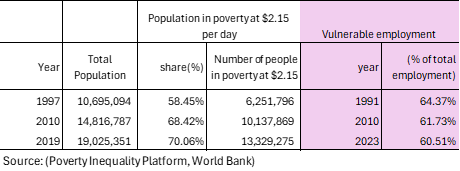
Poverty and vulnerable employment in Malawi
Understanding poverty level significance at $2.15 per day
In 2019, a significant 70 percent of Malawi’s population ( 13 million people) was identified as living in poverty at an income threshold of $ 2.15 per day. The poverty level at $2.15 per day (measured in 2017 purchasing power parity, or PPP) is a key global benchmark used by the World Bank to define extreme poverty in low-income countries. It indicates:
1. Basic Survival Threshold
• People living below $2.15 per day struggle to afford essential needs such as food, clean water, shelter, healthcare, and education.
2. Economic Underdevelopment
• A high percentage of a country’s population living below this threshold suggests low economic productivity, high unemployment, and weak social safety nets.
3. Inequality and Social Vulnerability
• It reflects deep income inequality and a lack of access to opportunities for upward mobility.
• People in this category are more vulnerable to shocks like food price increases, climate disasters, or health crises.
4. Policy Challenges
• Governments need targeted interventions such as social welfare programs, job creation, and improved access to education and healthcare to reduce poverty.
A country's export structure is a reflection of its level of development and productive capacities
The export structure of a country refers to the composition, diversity, and value of the goods and services it sells to other countries. It provides key insights into the country’s economic health, competitiveness, and level of development. Productive capacities of a country refer to its ability to produce goods and services efficiently and sustainably over time. These capacities are shaped by various factors, including human capital, natural resources, infrastructure, private sector, development, technology & innovation, institutions & governance, financial systems trade & market access.
Here’s what the export structure and productive capacities of a country typically indicate:
- Level of Economic Development
- Developed economies usually export high-value manufactured goods, technology, and services.
- Developing economies often rely on raw materials, agricultural products, or low-value manufactured goods.
- Industrial and Sectoral Strengths
- A strong presence of high-tech or industrial goods (e.g., machinery, electronics) suggests a well-developed manufacturing sector.
- A dominance of commodities (e.g., oil, minerals, agricultural products) indicates reliance on natural resources.
- Export Diversification
- A diverse export base (multiple industries) makes a country’s economy more stable and resilient to global price shocks.
- A concentrated export base (few key products) makes it vulnerable to market fluctuations.
- Trade Partnerships and Dependence
- If exports are heavily dependent on a single country or region, the economy is more exposed to geopolitical and trade risks.
- A wide range of trading partners indicates stronger global integration.
- Competitiveness and Value Addition
- Exporting mainly raw materials (e.g., crude oil instead of refined petroleum) suggests limited industrial processing capacity.
- A high share of finished and high-tech goods suggests strong value addition and competitiveness.
Malawi-Sanitation
Malawi- Proportion of population served with at least basic sanitation
In 2022, proportion of population served with at least basic sanitation for Malawi was 49.2 %. Proportion of population served with at least basic sanitation of Malawi increased from 9.4 % in 2000 to 49.2 % in 2022 an absolute change of 39.8 percentage points (pp) between 2000 and 2022.
Malawi- Proportion of urban population served with at least basic sanitation
In 2022, proportion of urban population served with at least basic sanitation for Malawi was 48 %. Proportion of urban population served with at least basic sanitation of Malawi increased from 24.2 % in 2000 to 48 % in 2022 an absolute change of 23.8 pp between 2000 and 2022.
Malawi – Proportion of rural population served with at least basic sanitation
In 2022, proportion of rural population served with at least basic sanitation for Malawi was 49.5 %. Proportion of rural population served with at least basic sanitation of Malawi increased from 6.8 % in 2000 to 49.5 % in 2022 an absolute change of 42.7 pp between 2000 and 2022.
Malawi – Proportion of population served with at least basic sanitation: A Global Perspective
The inadequate sanitation crisis poses a serious challenge that requires immediate and collective action, highlighting a critical public health emergency resulting in countless preventable deaths each year. Access to safe sanitation is a basic human right that must be guaranteed for everyone, regardless of their social or economic status. In 2022, around 11 million people, nearly 51 percent of Malawi’s population, faced the harsh realities of poor sanitation facilities, starkly contrasting with countries like Vietnam, China, and Thailand, where only 8 percent, 5 percent, and 1 percent respectively lack these essential services. The global average shows that approximately 6 percent of people lack adequate sanitation, emphasizing the pressing need for coordinated efforts to enhance sanitation access in the underserved regions of Sub-Saharan Africa, where the consequences are the most acute.
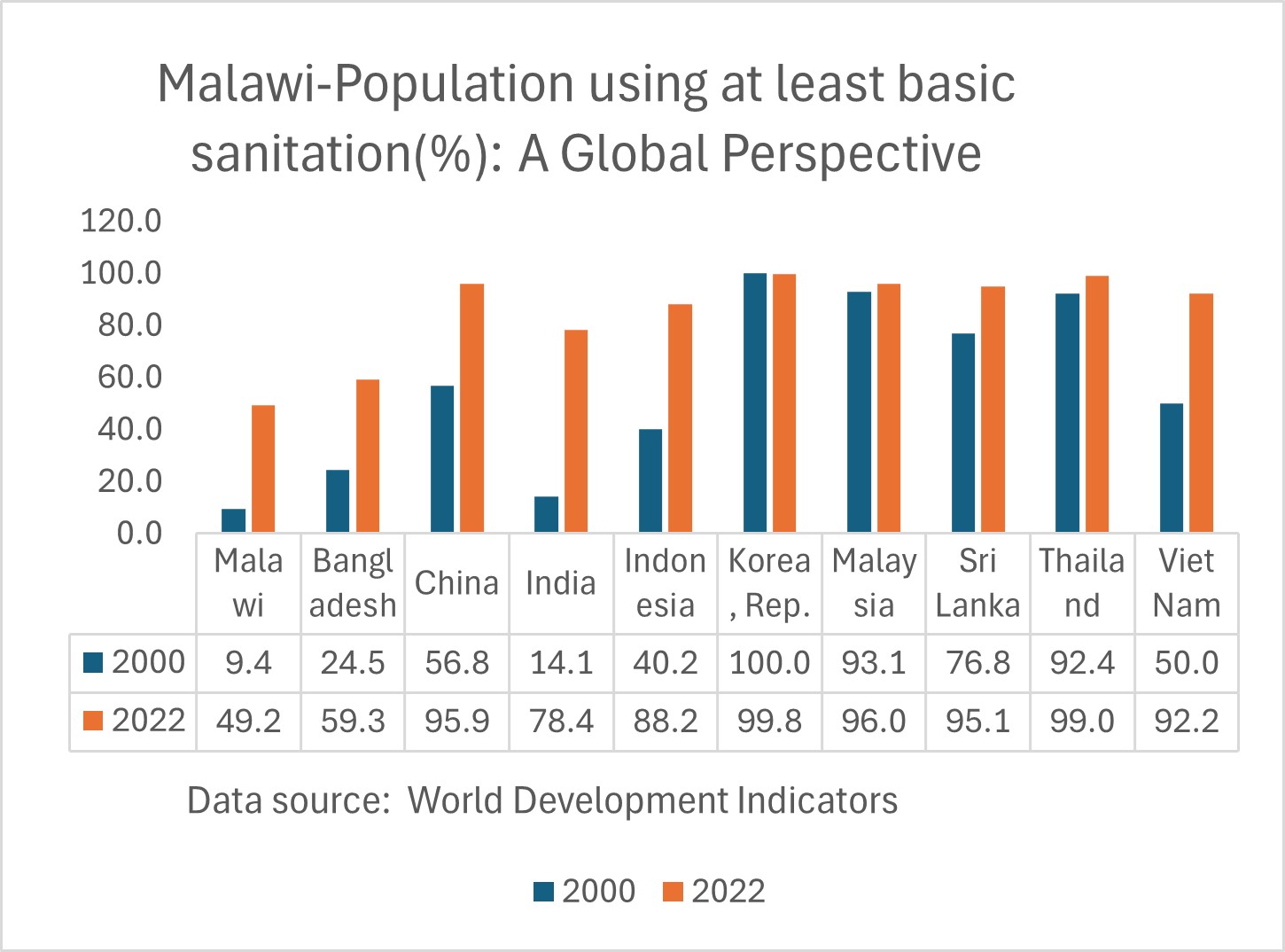
Malawi – Proportion of rural population served with at least basic sanitation: A Global Perspective
In 2022, nearly 9 million individuals in rural Malawi almost half the rural population tragically lacked access to basic sanitation facilities a stark contrast to the much lower figures in Vietnam, Sri Lanka, and Thailand where the statistics were just 12 percent 5 percent and 2 percent respectively. The lack of safe sanitation is not merely an urgent issue but reflects a troubling reality that calls for our immediate and compassionate action contributing to the loss of countless lives each year and intensifying a significant public health crisis. Safe sanitation is a fundamental human right that everyone deserves regardless of their circumstances. It is vital for us to unite in solidarity to advocate for this essential right across Sub-Saharan Africa where the need is pressing and the potential for transformative community change is crucial for the dignity and well-being of all affected.
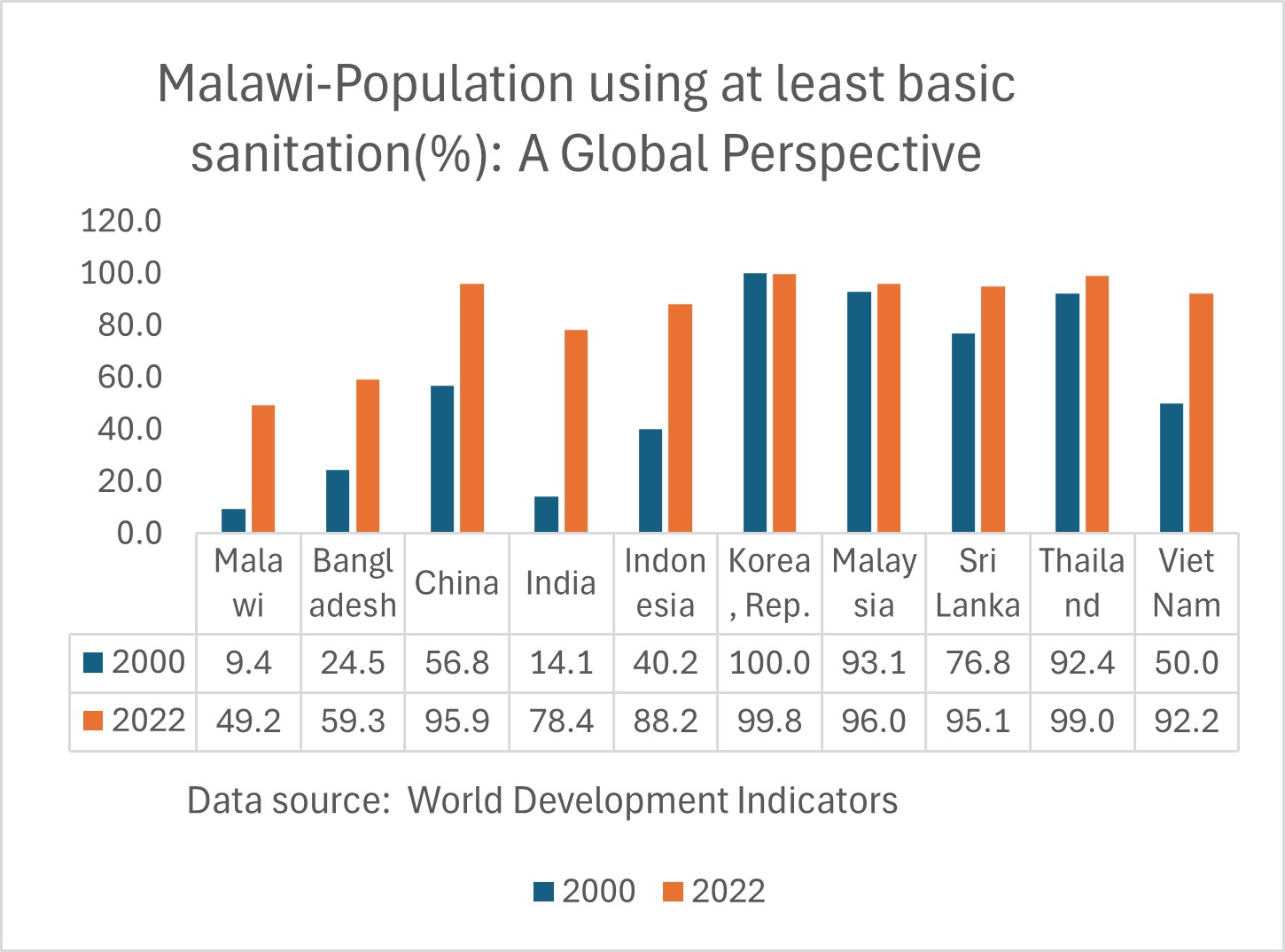
Malawi-Water Supply
Malawi – Proportion of total population served with at least basic water
In 2022, proportion of population served with at least basic water for Malawi was 71.9 %. Proportion of population served with at least basic water of Malawi increased from 53.8 % in 2000 to 71.9 % in 2022 an absolute change of 18.1pp between 2000 and 2022.
Malawi- Proportion of urban population served with at least basic water
In 2022, proportion of urban population served with at least basic water for Malawi was 85.9 %. Proportion of urban population served with at least basic water of Malawi increased from 85.8 % in 2000 to 85.9 % in 2022 an absolute of 0.1pp between 2000 and 2022.
Malawi – Proportion of rural population with at least basic water
In 2022, proportion of rural population served with at least basic water for Malawi was 68.9 %. Proportion of rural population served with at least basic water of Malawi increased from 48.4 % in 2000 to 68.8 % in 2022 an absolute change of 20.4 pp between 2000 and 2022.
Malawi- Proportion of population not served with at least basic drinking water: A Global Perspective
Malawi faces a significant challenge in access to safe drinking water, a fundamental need for its people. In 2022, around 6 million Malawians, or 28 percent of the population, struggled to access this vital resource, highlighting a public health crisis that demands our urgent attention. In contrast, countries like Thailand and 98 percent of individuals in Vietnam and Bangladesh enjoy reliable access to safe drinking water, revealing a stark disparity that weighs on our conscience. This inequality calls for immediate reforms in Sub-Saharan Africa, where many still lack essential resources for improving their quality of life. We must strengthen our commitment to closing this gap, ensuring that every person has access to safe drinking water, as this issue is a profound moral imperative for our global community. Tackling this crisis is not just about health; it is a crucial step toward achieving sustainable development goals that uplift us all, emphasizing the importance of collaboration and innovation for a healthier and more equitable future.
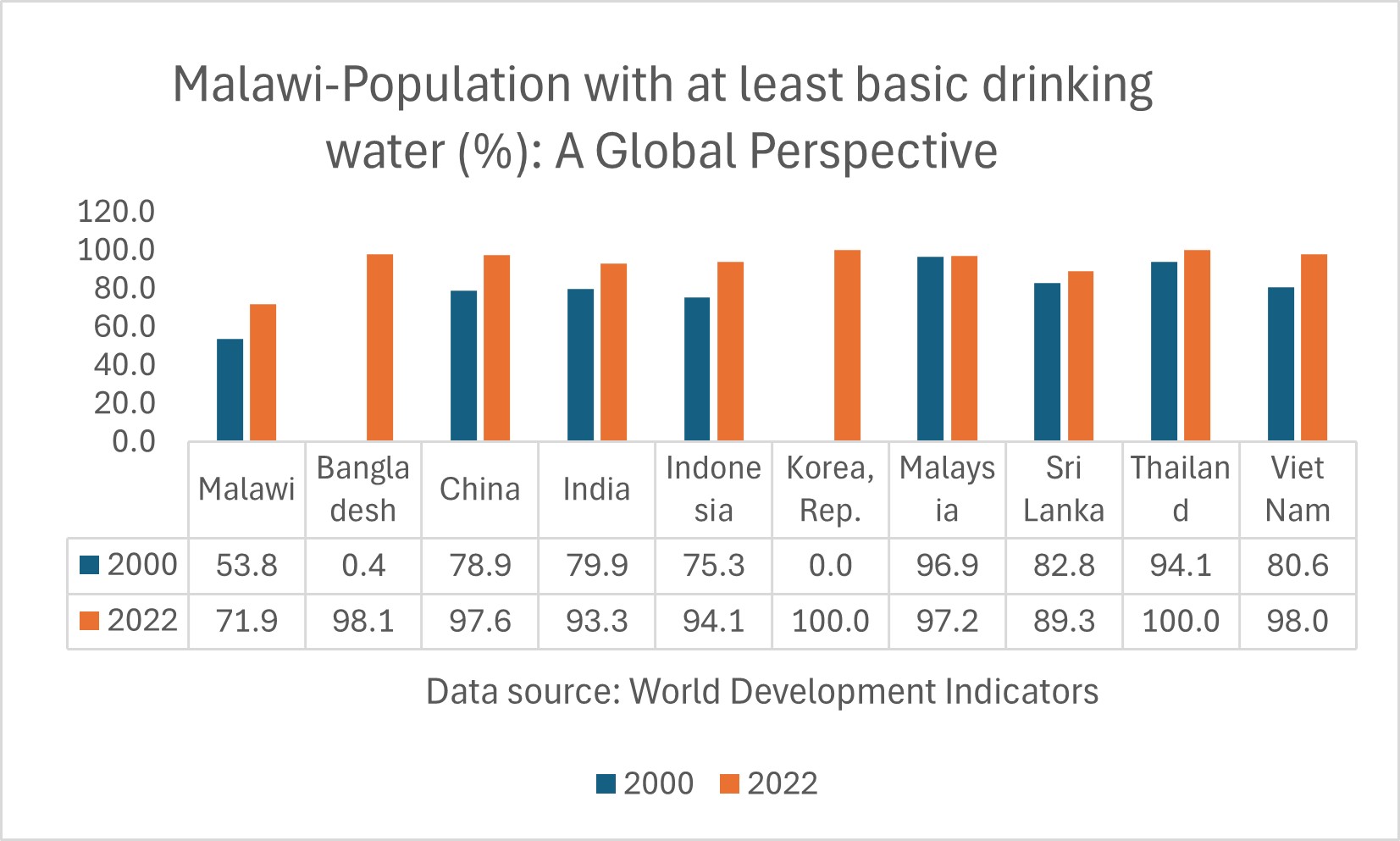
Malawi- Proportion of rural population served with at least basic drinking water: A Global Perspective
In 2022, it is alarming that 31 percent of Malawi’s rural population, about 5 million people, lacked access to safe drinking water, highlighting a pressing humanitarian crisis that requires our urgent attention. This situation not only threatens the health and well-being of these communities but also hinders their economic and social development. In contrast, countries like Thailand, Bangladesh, and Vietnam have achieved nearly universal access, with rural populations enjoying access rates of 100 percent, 98 percent, and 97 percent respectively. These successes demonstrate the impact of effective governance and resource management. This stark disparity reveals the significant governance challenges faced by many Sub-Saharan African nations and underscores the critical need for collaborative efforts to improve living conditions and ensure access to basic necessities for the most disadvantaged communities. The urgency for international cooperation and local empowerment has never been greater as we work together to bridge this gap and create a more just future for all.
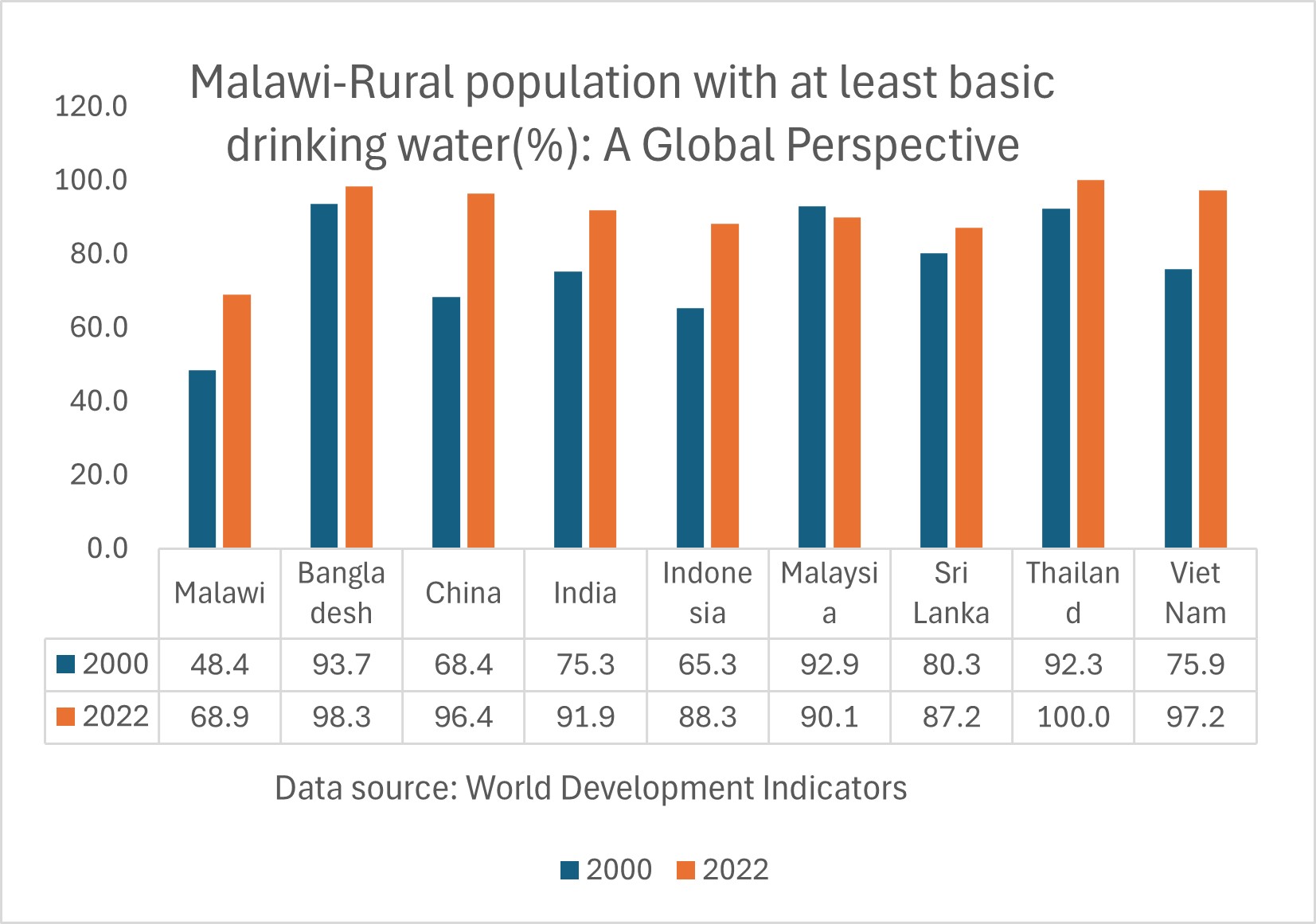
Malawi-Access to Electricity
Malawi-Access to electricity (% of population)
In 2022, proportion of population with access to electricity for Malawi was 14 % in 2022. The proportion of population with access to electricity of Malawi increased from 4.8% in 2000 to 14% in 2022, an absolute change of 9.2 pp between 2000 and 2022.
Malawi-Access to electricity (% urban population)
In 2022, proportion of urban population with access to electricity for Malawi was 54%. The proportion of urban population with access to electricity of Malawi increased from 28.7% % in 2000 to 54% in 2022, an absolute change of 25.3 pp between 2000 and 2022.
Malawi-Access to electricity (% of rural population)
In 2022, proportion of rural population with access to electricity for Malawi was 5.6 %. The proportion of rural population with access to electricity of Malawi increased from 0.7 % in 2020 to 5.6% in 2022 an absolute change of 4.9 pp between 2000 and 2022.
Malawi- Proportion of population served with electricity: A Global Perspective
Malawi faces a critical electricity access crisis, with nearly 86 percent of the population in Malawi lacking this vital service as of 2022. This situation impacts over 18 million people, undermining their daily lives and survival due to unreliable electricity. In contrast, countries like Vietnam, Thailand, Sri Lanka, and Malaysia have attained universal electricity access, highlighting the urgent need for transformative reforms in Sub-Saharan Africa to improve living conditions. The lack of stable electricity threatens essential sectors such as development, health, education, and economic growth, which are crucial for enhancing living standards and fostering hope for a sustainable future. Addressing this issue is essential for the immediate welfare of individuals and for building a foundation for long-term progress and a more equitable future for all.
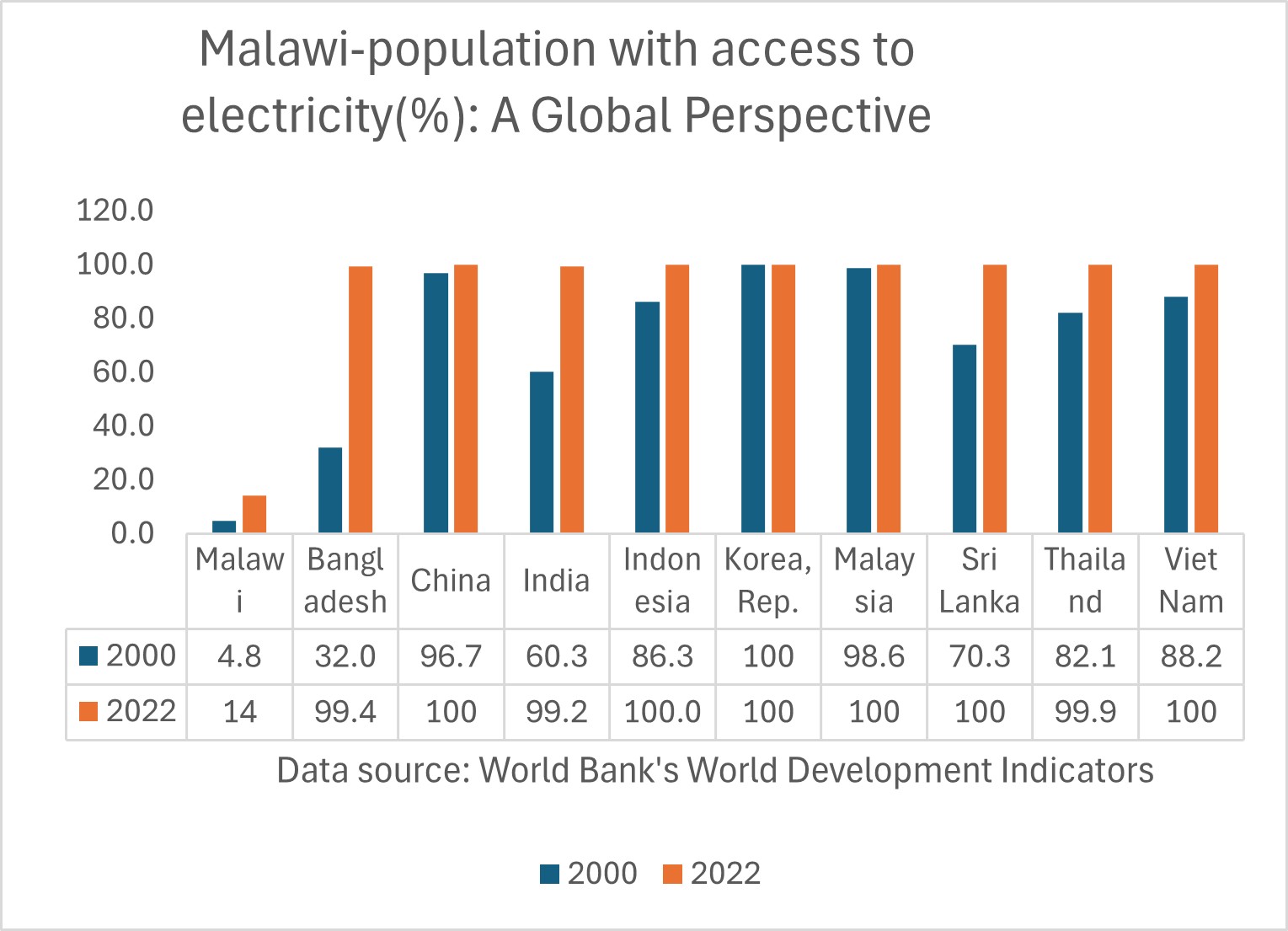
Malawi- Proportion of rural population served with electricity: A Global Perspective
In 2022, an astonishing 94 percent of Malawi’s rural population, around 16 million people, lived without electricity, highlighting stark disparities with countries like Vietnam, Thailand, and Sri Lanka, where all rural citizens have access to this vital resource. These figures emphasize the urgent need for governance reforms across Sub-Saharan Africa. By embracing these changes, we can ensure every community achieves reliable electricity access, fostering an environment that promotes growth and paving the way for a sustainable and prosperous future.

Malawi: Health outcomes
Malawi-Life expectancy: A Global Perspective
As we explore the evolving trends in life expectancy over the past seventy years, it is clear that humanity has made significant progress towards longer and healthier lives despite numerous challenges. The global average life expectancy for newborns has risen from 47 years in 1950 to 71 years in 2021, yet disparities remain, particularly in Sub-Saharan Africa. In Malawi, life expectancy improved from 35 years in 1960 to 63 years in 2022, reflecting the resilience of its people in the face of adversity. In contrast, countries like South Korea and the Maldives have seen remarkable advancements, with life expectancy soaring from 54 years in 1960 to 83 years in 2022, and from 39 years in 1960 to 81 years in 2022, respectively. The ongoing challenges faced by many Sub-Saharan African nations highlight the urgent need for collective empathy and transformative initiatives. Through collaboration, we can foster meaningful change and strive for a sustainable and equitable future that ensures the benefits of global progress are accessible to all communities.

Malawi-Mortality rate, under-5 (per 1,000 live births): A Global Perspective
Malawi’s efforts to reduce under-five mortality rates illustrate the remarkable progress that can be achieved when communities prioritize health and well-being. Since 1950, global child mortality rates have significantly declined due to improvements in living conditions, healthcare access, nutrition, and clean drinking water. While developed nations now report rates below four percent, it is crucial to recognize the advancements made by developing countries, despite ongoing challenges in Sub-Saharan Africa. In Malawi, the under-five mortality rate has fallen from 256 per 1,000 live births in 1980 to 40 per 1,000 in 2022, reflecting similar reductions in countries like Bangladesh and India. This progress demonstrates that with strong commitment and strategic collaboration, we can tackle the systemic issues of inadequate healthcare, advocating for vital reforms across Sub-Saharan Africa to ensure a healthier future for all children and their families.
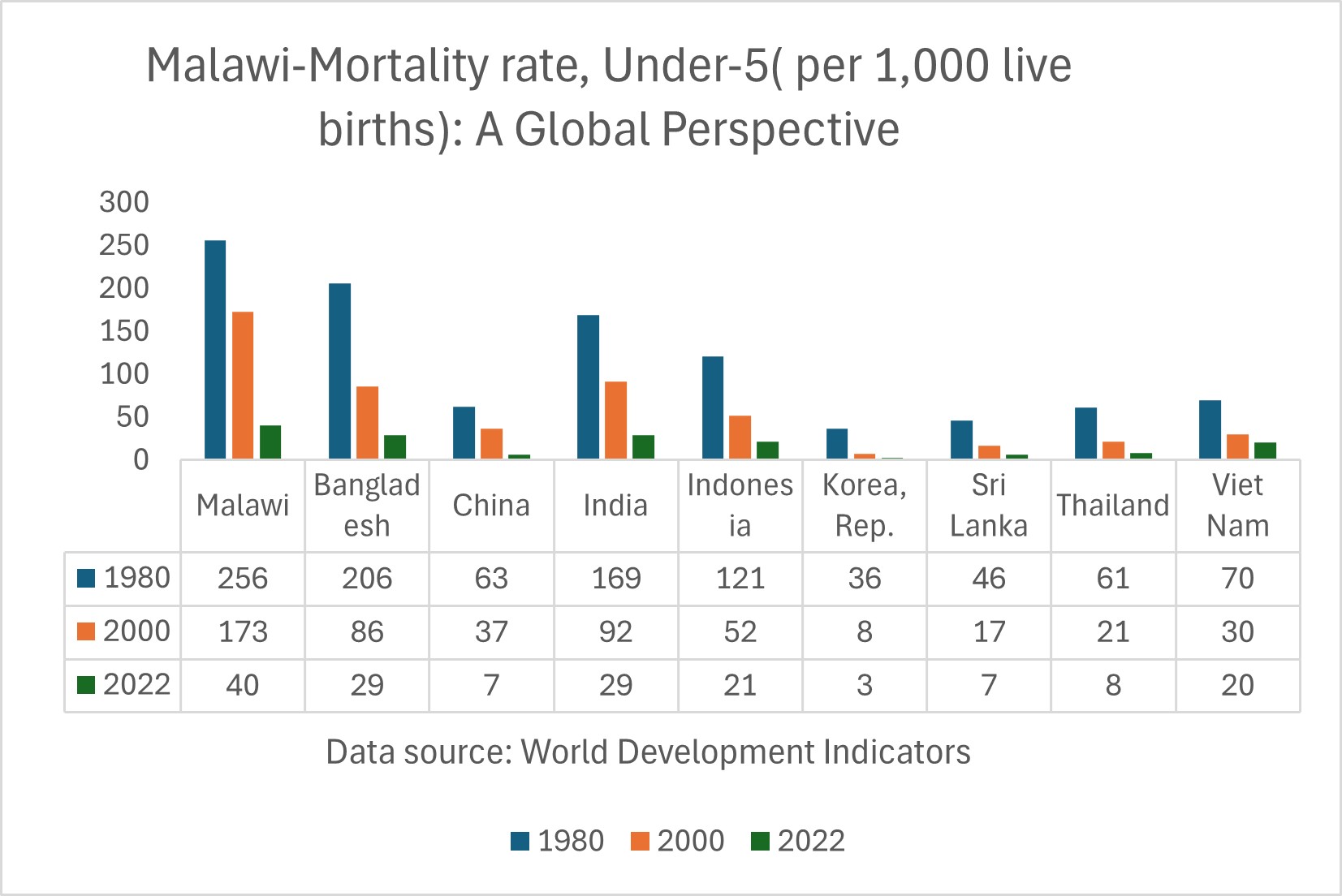
Malawi-Maternal mortality ratio (per 100,000 live births): A Global Perspective
Malawi’s maternal mortality ratio dropped from 573 in 2000 to 381 in 2020, yet this figure underscores the serious challenges mothers face nationwide. While this progress is commendable, it highlights the extensive work ahead, especially compared to lower ratios in Bangladesh, India, and Vietnam at 123, 103, and 46 in 2022. These alarming statistics reveal an ongoing crisis of pregnancy-related deaths, fueled by high birth rates and persistent maternal health issues needing urgent attention. Addressing gaps in the healthcare system and chronic underfunding in many Sub-Saharan African countries is vital for better maternal health outcomes. The significant disparities in maternal health compared to other developing regions call for immediate and compassionate action. Together, we can invest in health infrastructure and resources to protect mothers and their children in Malawi, ensuring that every maternal life is valued and supported.
